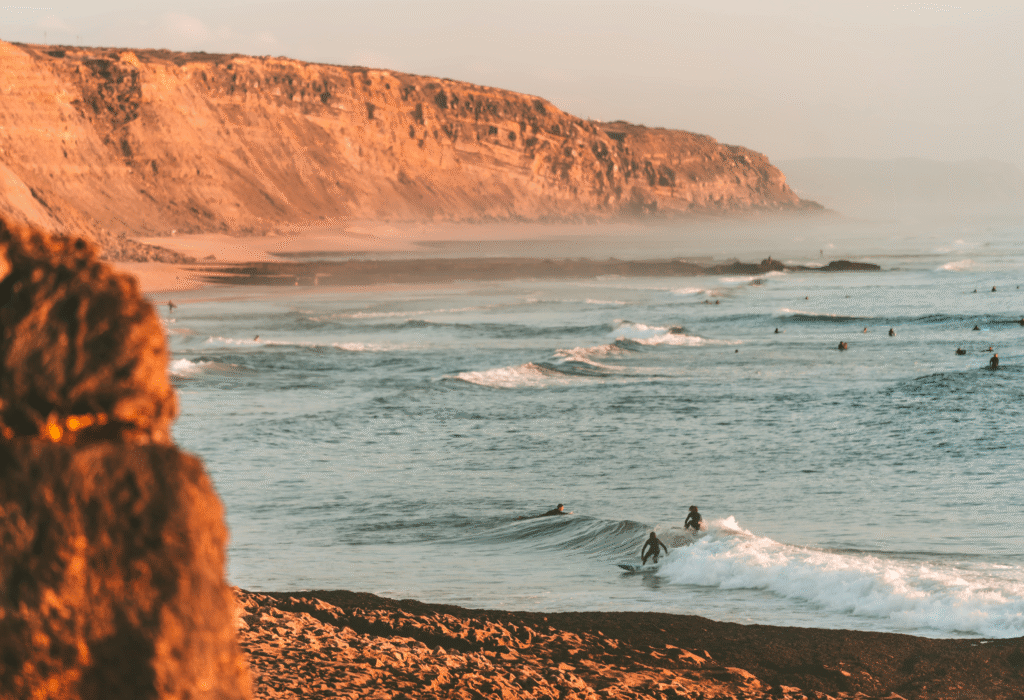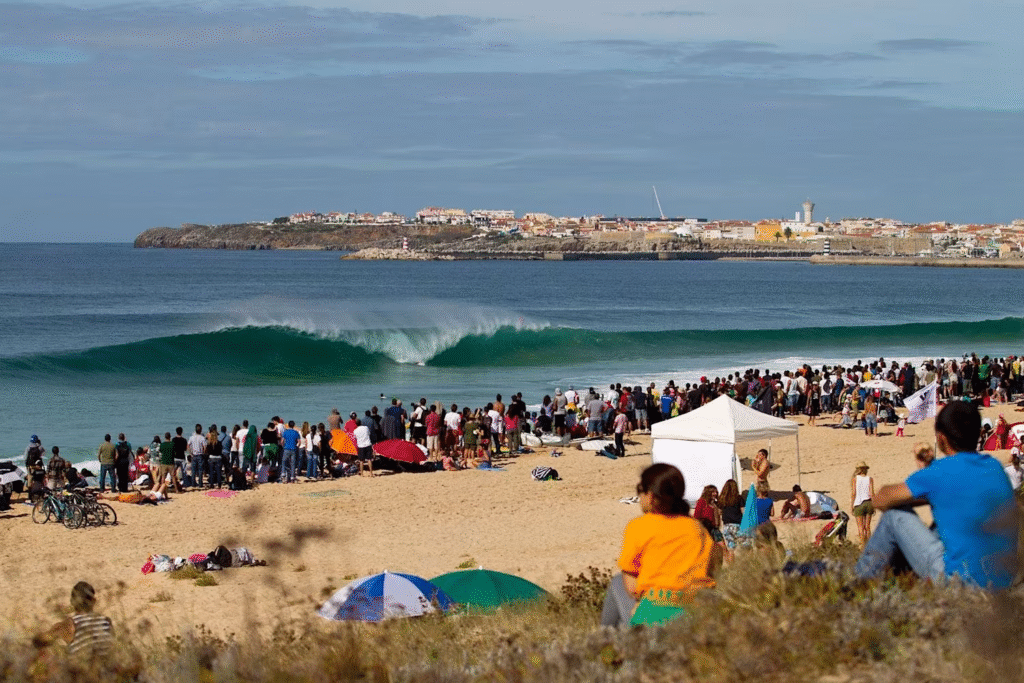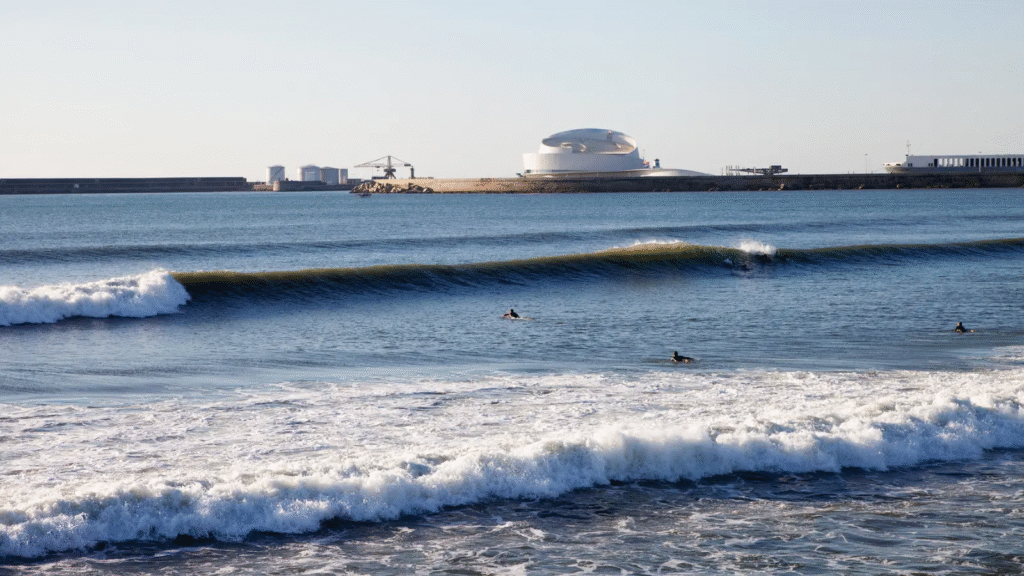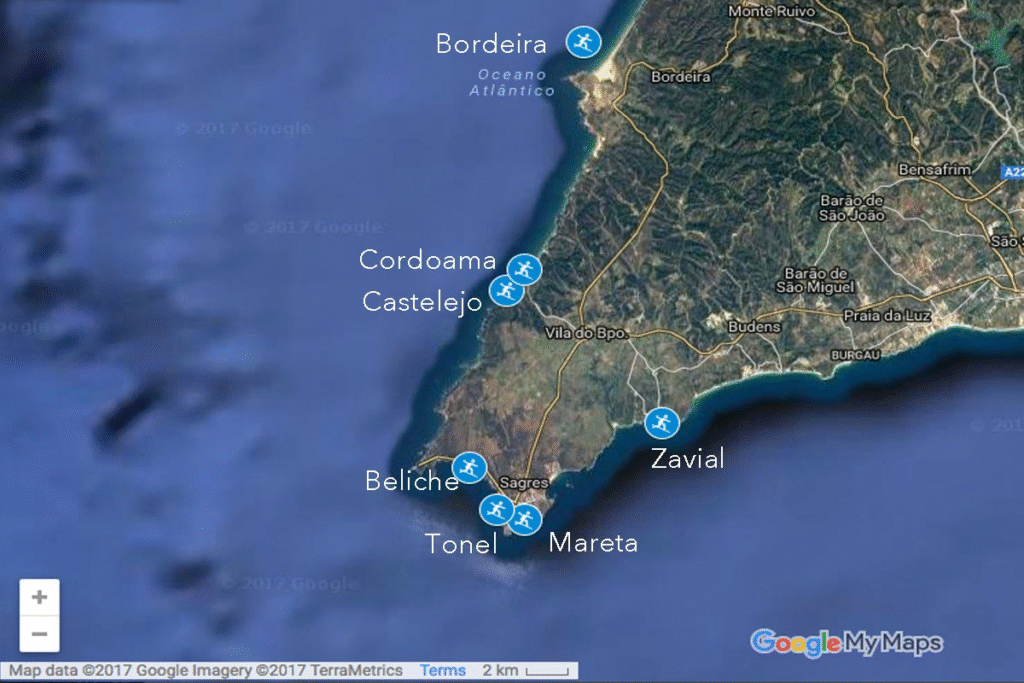Portugal is the 12th country in size among the 27 EU member states, but has 943km of Atlantic Coast – one of the longest. And that 943km of coast gets 300 days of surfable waves every year. On top of that, Portugal doesn’t get as crowded as Spain or France, so it’s a bit more chill. Yeah, surfing in Portugal seems nice now, right? You can find perfect waves all year round, whether you are a beginner or an advanced surfer.
Check this article out, too: What to do in Andalusia, Spain?
Surfing in Portugal has been popular since the late 20th century. There has been a thriving surf culture day by day, and it has turned some of its small cities into global hotspots. For example, Ericeira is the only World Surfing Reserve in Europe. It was a fishing town, and now it’s a small, cool surf town, one of the best you’ll see. Check out my article on surfing in Ericeira if you’re curious.
The reason why surfing in Portugal is special is the consistency. Anyone and anytime can find waves to surf at most of the beaches, from Sagres to Porto and above. Portugal is Europe’s surf paradise. Let’s check out the ultimate guide to the best spots for surfing in Portugal.

Why Portugal is a Top Destination for Surfing
I briefly mentioned why Portugal is great for surfing, but why exactly? The main reason is consistency and reliability. There are always waves. And those waves are always good to surf in. Ever heard of Nazaré (where Sebastian Steudter surfed the biggest wave ever surfed)? Yeah, it’s also in Portugal. You don’t have “seasonal luck” in Portugal; you always have luck here.
Thanks to its unique geography, this country catches swells from three directions, north, south, and west. Winter has 5+ meter waves, and summer has gentle 1-2 meter waves. They are great for beginners. I have surfed in Portugal in the summer a few times, and it’s super fun. From mellow beach breaks to Nazaré’s giants, the diverse coastline caters to everyone. Beginners love the gentle slopes of spots like Foz do Lizandro. Experts chase steep reef breaks like Coxos. Seven distinct regions mean you’ll never run out of options.
Best Time to Surf in Portugal
Surfing in Portugal is fun and nice, but part of that fun is knowing when to surf in Portugal. You would not want to be in Nazaré in winter if you are a beginner. The same goes for advanced students in Sagres in the summer. You must plan your surfing trip to Portugal around the key months when you can surf.
- Summer is mostly for beginners. The ocean is calmer, and the waves are smaller and more manageable. If you are catching your first waves or just want to practice, you should go in summer (generally May to September, July-August is the peak season). It’s more crowded, and line-ups, surf camps, and surf schools are mostly booked.
- Winter is for advanced or intermediate surfers. Waves get much bigger, mostly over 3 meters. You need a thicker wetsuit and be ready for some colder weather. It’s less crowded, and you’ll mostly see pros dominating the waters. November to March is perfect, generally December to February is the peak winter season. This is when you’ll get those monster waves.
- Shoulder seasons (fall and spring) are somewhat in between. You can still go if you are a beginner and practice; you’ll have fewer crowds, a bit better weather, and opportunities to surf a lot. If you are intermediate or advanced, you could still get some good waves, but not always.
Top Surf Regions in Portugal
Now comes the fun part. Surfing is also about knowing the spots. Not all spots could be good for you (although Portugal’s coastline is generally an exception to this). It’s different to surf in Ericeira than to surf in Figuera de Foz. Both are good, but Ericeira’s vibes are different. Here is a list of all Portugal’s good surf spots and regions.
Ericeira: Europe’s Surfing Capital
I mentioned Ericeira a lot, and there is a reason for that. It’s the top surfing spot in Portugal. This UNESCO World Surf Reserve has seven beaches with WSL-quality breaks within just 8km. Ribeira d’Ilhas is the most famous. Its long right-handers are a dream for intermediates. Advanced riders generally go to Coxos for hollow, fast waves that demand precision. Ericeira is also Europe’s only World Surfing Reserve.
- Ribeira d’Ilhas: This is the Legendary Break. Pros obsess over this right-hand reef. There are 300m rides with consistent surf and hollow sections. ASP World Tour stops here annually. This place is best if you go around dawn. Less crowd, better waves, and amazing views. Local secret: Park at São Julião for midday sessions if you want a little bit less crowd during the day.
- Coxos: Another reef for advanced and intermediate surfers. This right-hand point break has barrels that’ll test your limits. It’s a local heavy spot, so you must be more careful. No fancy GoPros or beginner surf camps. Mostly local or nearby pros or intermediate people in the line-up. Winter swells are amazing, there are a lot of barrels and great waves all around.
- Foz do Lizandro: This spot is great for beginners. It’s a sandy-bottom gem with consistent surfing and gentle inside waves. As you progress, you can paddle further out for rippable walls. It’s ideal for practicing turns. Pro tip: Book lessons here. Instructors leverage the break’s forgiving levels to fast-track your skills.

Peniche: Home of Supertubos
Peniche has a world-renowned beach break called “supertubos.” They are fast, hollow, and powerful barrels, and it is also often called “Europe’s pipeline.” You get these mostly in winter, and it’s cool because the waves break in very shallow water, creating extremely powerful barrels. Rip Curl Pro is hosted here every winter, mostly because of this. It’s definitely not easy to surf here in winter, so be careful if you are a beginner.
Peniche, geographically, is sort of an extension of the mainland, a very small region that you can drive around in 20 minutes. The city itself doesn’t have much, but the waves in every season are great. Even though it has supertubos in winter, summer is also great for beginners and learning to surf. The good thing is that if supertubos are really powerful, you can head to other spots like Baleal, a shelter spot with friendlier waves. If you prefer left breaks, go for Lagie, especially at low tide.
Pro tip: Watch the Rip Curl Pro from the cliffside. The amphitheater view lets you study every drop and dodge.

Lisbon Coast: Urban Surfing Paradise
Lisbon doesn’t need any introductions. If you are flying into Portugal, especially for surfing, you fly into Lisbon. Lisbon has a unique surfing scene in Portugal in many ways. There aren’t many places in Portugal (or in the world) where you can surf before breakfast and get to explore a capital city before and by lunch. You’ll spend most of your time trying to pick one.
- Praia do Guincho: Guincho is a different surfing spot in Portugal. Got a good mix of wind and waves (like Sagres). These cross-offshore winds create ramp waves that are perfect for some aerial tricks. You’ll also find kitesurfers in Guincho, mostly intermediates and pros. For beginners, it may be a little bit too strong.
- Carcavelos: Contrary to Guincho, Carcavelos is perfect for beginners who are learning. It’s a 1.5km beach and one of the top spots of Lisbon’s surfing scene. Full of surf schools and camps doing their lessons here. If you’re by yourself, dawn sessions on weekdays will have the least amount of crowds.
- Caparica: If you prefer some hidden gems that are a bit farther away from the city, go to Caparica. All levels can surf here, depending on the season.

Surfing in Portugal’s North: Porto and Beyond
Northern Portugal doesn’t get as much attention from the surfing community, but it’s got some killer waves and beaches. You can get amazing surf sessions by just a short train ride from a big, vibrant city like Porto. The number of breaks and spots is not as good as some parts of Southern Portugal, but it’s still amazing.
- Matosinhos: Go to Matosinhos with Porto’s metro line B, and you will get a beach with consistent breaks. Takes 10 to 20 minutes, and you can grab a morning session before work. The good thing about Matoshinos is that it gets consistent waves year-round, and all levels can surf. Like other spots, winter is the best time if you are looking for some big waves.
- Espinho: One of the perks of Northern Portugal is that there are a lot of hidden gems with empty line-ups. Espinho is one of the best ones. Local surfers guard this northern jewel, but respect earns you epic rides. However, watch for shallow rocks at Aguçadoura, as it can get dangerous.

Algarve: Sun, Sand, and Surf
The Algarve is one of the most popular regions of Portugal, not just for surfers, but for all kinds of tourists and travelers. It has an amazing culture, good weather, and all the things Portugal has. You can find all of these here. Algarve is a region, though, not a city. So you’ll need to find the best city that fits you. That’s why I’ll talk about the cities rather than surfing spots in the Algarve. It’s much easier. But in a nutshell, you’ll have Sagres, Lagos, Portimao, and Aljezur.
- Sagres: This city is known as ‘the end of the world.’ When it was first discovered, people thought it was actually the end of the world because it’s Europe’s most southwestern tip. You get waves here year-round, but winter is a different monster. Between October and April, the waves are the best. It also has both left and right hand. Beliche for left, Tonel for right. Because it’s very cliffy and extremely windy (you get crazy from the wind here, it’s bad), it creates the perfect waves.
- Lagos: Lagos is closer to the Algarve’s center and much bigger than Sagres. You’ll have more options outside of surfing here, and the waves will also be great. Meia Praia is great for beginners, and Ponta de Piedade is great for pros in the winter with its hollow reefs.

Azores and Madeira: Remote Surf Adventures
These islands are not the most frequented surf destinations, but if you want different vibes, definitely check them out. Untouched places with some wild views. Since they are not as popular, you can get some uncrowded breaks and fun surf days. São Miguel Island itself is a great surfing spot, for example.
- Ribeira Grande in the Azores: Ribeira Grande is the Azores’ gem. This Azorean gem serves up powerful reef breaks. Winter swells here? Jaw-dropping. Expect hollow waves that challenge even pros. Direct flights from Boston to Ponta Delgada make this remote trip surprisingly accessible.
- Paul do Mar in Madeira: Madeira’s crown jewel hosted the 2012 ISA Championships for a reason. A submarine canyon funnels energy into colossal waves. Local legend Hugo Vau, still shredding at 68, proves this spot has timeless appeal.

Surf Camps and Schools in Portugal
If you are a beginner or intermediate, chances are, you’ll be looking into surf camps or surf schools/lessons before your surfing trip to Portugal. Since the country is full of surf spots and very popular in Europe, you will find a lot of surf camps in Portugal. If you are really into learning, I suggest going to a surf camp for at least a week. Standalone classes will not be any good. You can take lessons if you are intermediate or advanced to get better at certain things.
Choosing the Right Surf Camp
If you prefer to go to a surf camp, how do you choose the right surf camp? What should you look for? It’s not easy. I’ve done surf camps in Ericeira and Sagres, and they were both good. But I spent weeks choosing them. It mostly depends on what you are looking for. What’s your level, and what kind of things are you looking for?
There are some surf camps where you can just book surf lessons during your stay, and there are some that are ‘full-inclusive’ that give you breakfast, lunch, and generally 4 or 5 surf lessons for a 6–7-night stay. This is a bit intensive, but you should aim for this if you really want to learn and enjoy your time.
You should also look for camps at the right location at the right time. A beginner should not go to a camp in Peniche or Nazaré in winter. You should go in summer and to places like Ericeira, Lisbon, and maybe the Algarve. Read all the reviews carefully.
What to Expect from Surf Lessons
If you end up booking standalone surf lessons, that could also be good. It’s a bit easier to choose because, essentially, you only need a good surf instructor. You generally get 2 hours of water time and the gear for your price (about 50€/day). Your instructor will also look for the currents before you can go into the water.
With surf lessons, you generally get something for one lesson, depending on your level. If it’s your first time, you’ll mostly focus on learning the surfboard and just getting up on white water; that’s it.
Conclusion
Surfing in Portugal is fun, with endless amounts of surf spots, beautiful beaches, and waves all year-round. Go to Sagres if you want both left- and right-hand breaks. Check Ericeira if you want some world-class waves, and go to Nazaré if you want to see some of the biggest waves ever. There is something for everyone. You have all kinds of surf camps and surf lessons to choose from, and you can even go on your own surf trip in a car.
From the North to the South, you will find somewhere to surf in Portugal. It boils down to your choices. Do you want the sunny Algarve, world surf reserve Ericeira, or the North Portugal with some amazing wines to drink after surfing?
FAQ
When is the best time to catch great waves in Portugal?
Winter brings powerful swells, while summer offers smaller, cleaner waves—ideal for beginners. The sweet spot? September to November for consistency and fewer crowds.
How crowded are the surf beaches in Portugal during peak season?
Popular spots like Nazaré get busy, but dawn patrol or exploring lesser-known areas like Espinho means more space for you.
Do I need a wetsuit year-round in Portugal?
Yes! Even in summer, water temps rarely exceed 68°F. A 3/2mm suit works for warm months; winter demands 4/3mm or thicker.
What makes Portugal’s coastline unique for riding waves?
497 miles of west-facing exposure to Atlantic swells creates everything from mellow beach breaks to 100-foot monsters—all within a few hours’ drive.